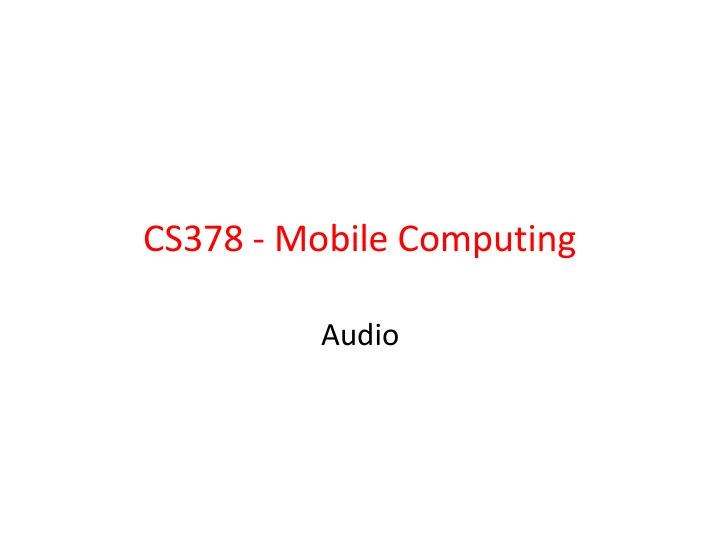

CS378 - Mobile Computing Audio
Android Audio • Use the MediaPlayer class • Common Audio Formats supported: – MP3, MIDI (.mid and others), Vorbis (.ogg), WAVE (.wav) and others • Sources of audio – local resources (part of app) – internal URIs (Content Provider for other audio available) – External URLs (streaming) 2
MediaPlayer • Playback control of • Playback Complete MediaPlayer managed • Stopped as a state machine • End • Idle • Invalid state transitions • Initialized result in errors • Preparing • Prepared • Started • Paused 3
MediaPlayer State Diagram • Single arrows are synchronous transitions • Double arrows are asynchronous transitions 4
Simple Sound Demo App • audio files local to app placed in res/raw • CAUTION – large sound files difficult to install on emulator: – http://tinyurl.com/3pwljfj – better success with dev phones / actual devices 5
Playing Local Audio • To play audio local to the app • use the MediaPlayer.create convenience method – when complete MediaPlayer in the prepared state • start MediaPlayer • approach: – build listeners for each button to call the playSound method with appropriate song id when clicked 6
Simple Approach button ids ids for sound files 7
playSound method • okay for short sounds • downsides: – plays to completion – multiple sounds play at same time (desirable in some cases) – audio continues to play when app paused 8
Changing Behavior • Add instance variable for MediaPlayer • If playing stop and release before creating new Player 9
Cleaning Up • Current version does not end well • Audio continues to play if back button pressed and even if home button pressed! • Activity Life Cycle • on pause we should stop MediaPlayer and release 10
stopPlayer method • Connect app stop button to stopPlayer – could use XML onClick and add View parameter or set up listener ourselves in buildListeners method 11
onPause • onPause() should call the stopPlayer method • what happens if activity resumed? 12
Saving State • Resume music where we left off if paused or activity destroyed due to orientation change 13
Saving MediaPlayer State • Not a lot of data so used the SharedPreferences 14
Restarting Audio • In onCreate check if audio was interrupted recreate player with same id and move to correct position • Can write data to shared preferences or bundle (onSaveInstanceState) and pull out in onCreate • Possible fix for orientation changes – in app manifest file under activity field android:configChanges= "orientation" - But now we are responsible for orientation changes - http://developer.android.com/guide/topics/resources/runtime- changes.html#HandlingTheChange 15
Playing Audio from Phone • If audio is on device / system, but not local to app use a URI • Obtain URIs of Music via a Content resolver • Example of simply listing URIs to the logcat 16
Retrieving Music URIs 17
MediaPlayer and System Audio • After URI retrieved can play audio with MediaPlayer • this approach requires calling prepare yourself – no convenience method 18
Playing Audio Via Local URI • id obtained via approach from showContent method 19
Other Audio • Other audio for ringtones, notifications, and alarms can be accessed via a RingtoneManager • Obtain URIs and play with media player • from DDMS: 20
Listing Other Audio 21
Playing Other Audio • Once the URI is obtained, playing other audio is same as playing song 22
Playing Audio from Remote URL • Straightforward given the URL 23
Completion of Audio • If action required when audio done playing implement the MediaPlayer.onCompletionListener interface • could make activity the listener 24
Looping • to loop sound (play over and over) simply set the isLooping method of the MediaPlayer to true 25
SoundPool • Another Android class 26
Using SoundPool • Great for applications with a number of short sound samples • maxStreams parameter sets maximum number of sounds that can be played at once via this SoundPool • If max is exceeded stream with lowest priority stopped – and then by age (oldest) with lowest priority 27
SoundPool play 28
Using SoundPool • Looping of sounds: 0 no looping – -1 loop forever – >0, play that many times – • frequency (speed) can be changed – range from 0.5 to 2.0 – 0.5 twice as long to play – 2.0 half as long to play 29
Recommend
More recommend